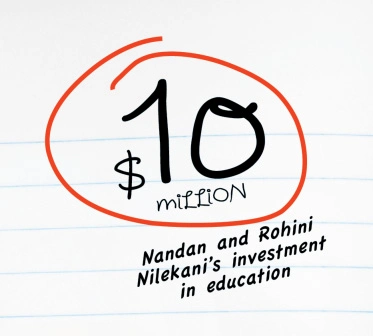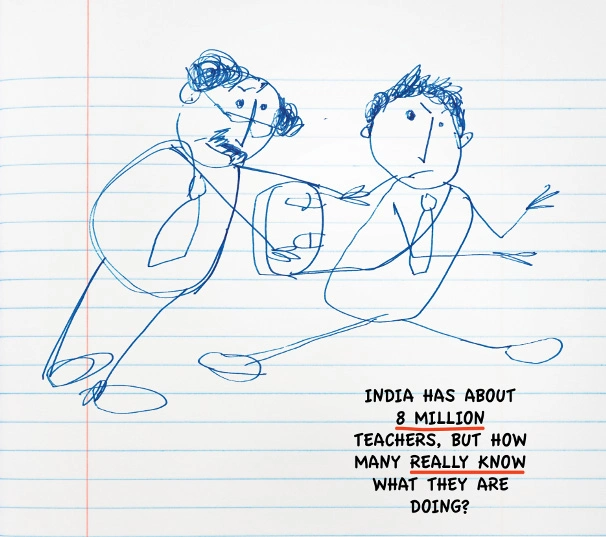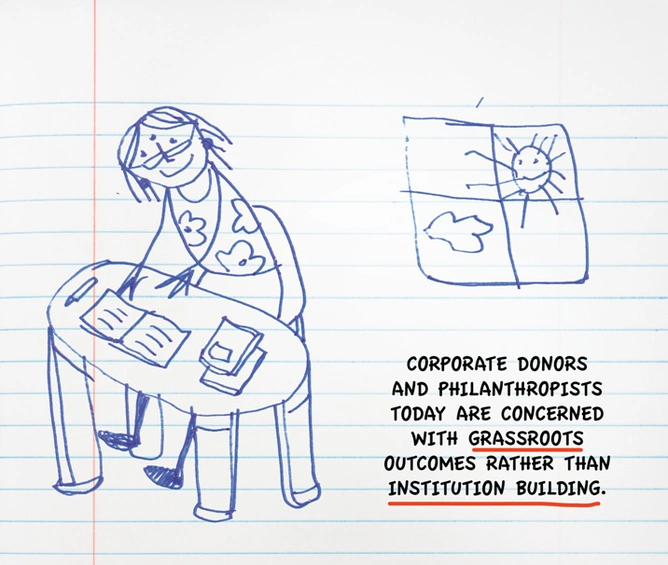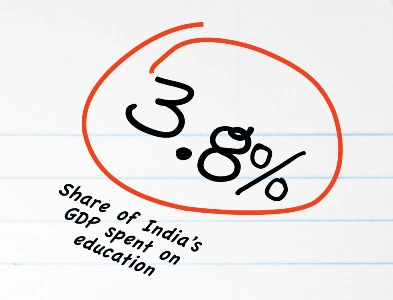ANURAG BEHAR IS ANGRY. “It’s a gigantic scam,” the CEO of the Azim Premji Foundation and vice chancellor of the Azim Premji University tells me when I quiz him on his pet peeve, the quality of teacher training in India. Behar believes that the real problem with Indian education—which has a bleak record in most vital parameters despite a near-100% school enrolment rate—lies not with the students but with the teachers and the teachers of teachers. In his words, “We have by far the worst teacher education system.”
His critique makes sense if you consider the shoddy manner in which teacher training has often been treated in policy circles. For instance, in 2008, the National Council for Teacher Education, which controls the setting up of private teacher training colleges, greenlighted 291 colleges—over just two meetings. Behar helped draft the Justice Verma Commission report on teacher education, which recommended a complete overhaul of the system. Among other things, the report called for stricter regulations to ensure India had enough qualified professionals who could prep the next generation of teachers. “Every university in the U.S., for instance, has a school of education. Every year the U.S. produces nearly 15,000 teacher training specialists for a population of 320-odd million; the number in India for a population of 1.2 billion is barely 800 to 900,” Behar says.

He then asks me a scary question: India has about 8 million teachers, but how many really know what they are doing?
That question is the reason why the Azim Premji Foundation has trained more than 1,000 people to guide and assist government school teachers. The programme runs in eight states—Andhra Pradesh, Bihar, Chhattisgarh, Telangana, Madhya Pradesh, Rajasthan, Karnataka, and Uttarakhand—which together have some 350,000 government schools.
In a bigger move, in 2010, Premji set up a Rs 1,000 crore university which focuses on producing education specialists. Each year, about 500 students pass out of it. At the moment, the university generates up to 7% of its revenues in fees; the rest comes from the Wipro founder. At its “stable stage”, Behar says, it will generate about 20% of revenues from fees.
“It will never make money. It is not built for that. The public sector by its very nature cannot invest large sums in untested models. This is where investment by entrepreneurs comes in. We are showing that the model works,” says Behar, who is enthused that in the last couple of years 30 new schools of education have sprung up in central universities. “I am doubtful if this would have happened if examples like ours had not been showcased.”
Premji, the first Indian to sign Warren Buffett’s Giving Pledge, has donated half his stake in the $9 billion (Rs 56, 853 crore) Wipro to his foundation. He is not alone in writing big cheques to prop up India’s rickety education system. Infosys co-founder Nandan Nilekani and his wife Rohini’s $10 million endowment; Anu Aga, whose family company Thermax gives away 2% of its profits; Shiv Nadar’s Rs 3,000 crore corpus...Education has never had it so good.
More important than the money though, the private sector is influencing policy. Kunal Kumar is the municipal commissioner of Pune and has been working with education NGO Akanksha Foundation, where Aga is a key donor, for over half a decade. “In municipal schools, students don’t pay anything and teachers get paid a fixed salary, so how does one build quality standards? This is where private entities come in,” says Kumar. He says municipal schools run by private bodies “set examples of what is possible”—in everything from maintaining registers to curriculum and gradation standards—“and those standards are then built into policy”.

Many of the schools that Akanksha supports have a unique model, where the local municipality provides the building and the mid-day meals, while Akanksha takes care of providing trained teachers and educational aids for students. “The idea is to showcase how model schools can work through collaboration between the government and the private sector,” says Kumar. “It is an invaluable partnership.”
(Akanksha also trains teachers. Aga says she has seen instances of teachers borrowing money to get the certificate so that they can land a job in municipal schools, and then hiring a proxy to teach in their place while they take up a different, higher-paying job to pay off the loan.)
Then there’s Rohini Nilekani’s work with Bengaluru-based not-for-profit Akshara Foundation, which has influenced many initiatives of the Karnataka government, including state-wide Kannada and mathematics learning programmes. Nilekani is also a force behind the Annual Status of Education Report (ASER)—widely accepted as the country’s most credible study of its kind—which pushes policymakers to prioritise learning outcomes and not just inputs.
Manish Sabharwal, chairman of staffing services company TeamLease, was inducted into the Central Advisory Board of Education, India’s highest education advisory body, last year. He points to The Apprentices Amendment Act of 2014, which made hiring of apprentices easier, and garnering the consent of 18 states to remove the “no detention” policy from the Right to Education (RTE) Act as major wins. “No detention meant that lots of students were dropping out at Class 8, or around the age of 15. They would join the labour market with very little functional skill,” says Sabharwal, who sees the struggles of underskilled candidates up close in his corporate role. Each year, TeamLease gets 90,000 applications for about 4,000 open positions.
UNDERLYING ALL THESE disparate efforts, from Premji to Nilekani to Sabharwal, is a larger trend—education is emerging as a powerful unifier within India Inc. Captains of Indian industry often differ on critical issues, whether it’s the environment, land acquisition, or foreign direct investment. (Why, they cannot even agree on lower taxes: Infosys founder N. R. Narayana Murthy has often spoken on why he feels many businesses do not deserve tax breaks.) But on education they are increasingly speaking in one voice.
You might say they have no choice. India’s classrooms are broken, threatening to turn its much-vaunted demographic dividend into a disaster. Around 18 million Indian children get to school each year, but, as ASER consistently finds, half of them when tested in Class 5 cannot read or do basic mathematics. More than 50% of the kids who get into school drop out in either primary or elementary school. Beyond school, only 2.5% of Indians joining the workforce (about 11 million people) have any vocational training.

“India Inc. has been lazy for a long time. There was always this pool of labour ready to be tapped into. Not anymore,” says Pramod Bhasin, former CEO of outsourcing firm Genpact and founder-chairman of the Skills Academy, which has provided vocational training to around 28,000 people across 10 states in the past three years. “The competitive advantage of cheap and trained labour is finished. And it certainly won’t come back in the future. It will only get a lot worse,” says Bhasin, who is also a member of the national skill development council of the Confederation of Indian Industry. “What I am saying will not make many people happy, but everyone knows this is the truth. It is a crisis.”
To be sure, Indian philanthropists have always been big benefactors of education. Some of India’s best-known colleges, including Delhi’s Lady Shriram College and the Shriram College of Commerce, were funded by Lala Shriram, founder of Delhi Cloth and General Mills—the parent company of today’s DCM group. The Tatas, India’s largest conglomerate, built, among other institutions, the Tata Institute of Social Sciences and the Tata Institute of Fundamental Research in Mumbai. So what is different about the current wave?
Educationist Meeta Sengupta says many Indian corporate donors and philanthropists today are concerned with grassroots outcomes rather than institution building. Says Sengupta: “There is an understanding that education policy in India in the years after independence had a narrow focus on getting everyone up to a particular baseline. And so, while India built some world-class institutions, our average [quality] remained low.”
There is also a feeling that the RTE Act, introduced by the previous government, perpetuated the emphasis on buildings and not learning. Anil Sadgopal, member of the All India Forum for Right to Education, and former dean, faculty of education, Delhi University, has written that in essence the RTE incentivised the wrong things. In the rush to tick the boxes, more structures came up, but there was simply no push to improve quality.
The malaise is reflected in the abysmal performance of Indian students in the renowned Programme for International Student Assessment (PISA) test, which Chinese students regularly top. In 2009, India ranked above only Kyrgyzstan among 74 countries. The government tried to cover up by saying that there were “language issues”. In 2013, India refused to participate in the exercise.
To what extent can these problems be attributed to shortfalls in the government’s education budget? The United Nation Development Programme’s Human Development Reports say India spends 3.8% of its gross domestic product on education, comparable to 3.9% in China. Finland, which is widely considered to have the best education system in the world, spends 6.8%. Behar points out that Finland and China are at a “stable operating phase” and not “investment phase”. “Till 1985, we spoke a lot about universal education but never really invested in it. Unless we spend 10% or 12% at investment phase, which is where we are now, we are not going to get the results that we need,” he says.

Behar argues that entrepreneurial money gravitates towards education for two reasons. “Some of it is instrumental—that one day this will feed a need gap in the economy. But there is also an instinctive belief that India needs educated citizens to succeed as a democracy.” It sounds like something that should be part of the government’s manifesto, but Rohini Nilekani says philanthropic capital can do what government can’t—be creative and take risks. “Government can scale up things, but it can’t usually innovate well. That’s where private money comes in,” she says.
IN ECONOMIC TERMS, India is hitting what is known as the Lewis Turning Point. The phenomenon, named after the Nobel-winning Saint Lucian economist W. Arthur Lewis, describes a point in an economy when surplus rural labour runs out and urban wages start to rise sharply. China started to face this from 2010 onwards as cheap factory labour dried up. While the Lewis Turning Point relates to agricultural labour, in an economy as dependent on services for growth as India, its risks are equally valid for educated and trained labour.
The fear is that the bravado around India’s youthful population has deflected attention from this. “The growth that India is experiencing today has a lot to do with the low oil prices,” says Tirthankar Roy, professor of economic history at the London School of Economics. “The fundamentals of labour are not being factored in.”
He finds support in the Nilekanis. “When economies like Japan, Korea, and China started their growth trajectory, they had a fully literate population. But we are entering our growth phase with a large uneducated or insufficiently educated population. This is going to be one of the biggest bottlenecks to growth and inclusion in the future,” says Nandan Nilekani.
He is right. Consider China, whose breakout growth has been the benchmark for the entire developing world, including India. China has a literacy rate of 95% compared to 74% in India, but the gulf is even wider than those numbers suggest. An average Chinese child attends schools for about 12 years, whereas her Indian counterpart stays in school for a little over four years.

To the Nilekanis, it was obvious that solving the education problem at scale would require interventions beyond the classroom. A couple of years ago, while on a visit to Harvard Business School, they met Anant Agarwal and Sanjay Sarma. Agarwal is CEO of EdX, one of the world’s most influential massive open online courses (MOOCs) platforms, and Sarma is vice president of open learning at the Massachusetts Institute of Technology (MIT) and the man in charge of putting MIT content onto EdX.
Their conversations have taken the shape of EkStep, a digital platform to assist literacy and numeracy among children between 5 and 12, particularly first-generation learners. The EkStep website says its mission was inspired by a couple of questions that Rohini, with her decades of experience in the education sector, asked: “How can we use the latest advancements in learning sciences and digital technologies to help millions of young children personally experience the joy of learning? Can we use technology to help improve learning levels of young disadvantaged children?”
The platform, which has been built through a collaboration between “parents, teachers, educationists, technologists, content developers, scientists, and researchers”, includes a free-to-use Android app called Genie and content that can be accessed online as well as offline. It has already run two pilots, the latest in January with 100,000 students.
Says Nandan: ‘We are creating the platform and the technology which can be used by a wide range of content creators for all kinds of content.” The thinking has a clear imprint of his stint at the helm of the government’s universal identity programme Aadhaar, which is also based on the vision of incubating an ecosystem of collaborative, open-source apps and content driving citizen services.
Getting the infrastructure right is only half of the challenge. Monitoring progress in the long term is equally critical. That’s the true north for Shiv Nadar, whose foundation operates the VidyaGyan schools in backward regions of Uttar Pradesh, the Shiv Nadar University, and a grassroots education initiative Shiksha touching nearly 10,000 students. Nadar’s focus is on “long- and very-long-term interventions that will change society and add to India’s GDP”, his daughter and foundation trustee Roshni Nadar had told Fortune India for an earlier story (‘Shiv Nadar’s Biggest Dare’, April 2014). “There can’t be an expiry date.”

Aga of Thermax, who has supported education for two decades, follows the same philosophy. The Pune-based engineering firm, majority owned by Aga and her family, began by giving away 1% of its profits, going up to 3% before settling at 2%—the government requirement for corporate social responsibility. The Thermax Foundation supports five of the 15 schools that education NGO Akanksha runs in the city. “Four of our children have got into United World College with full scholarship, five after 12th standard have gotten into Azim Premji University with full scholarship. You can see how the investment changes lives,” says Aga. “We track our students until they get a good job among good people.”
SABHARWAL OF TEAMLEASE SAYS it is impossible to have a one-size-fits-all approach to education if jobs are the goal. “What does the student do once they complete their education? This is what industry understands best.”
Sabharwal believes a much-needed shift in mindset, with sharp focus on outcomes, is under way in the government. Consider Prime Minister Narendra Modi’s latest education reform ideas, which include sharing recruitment scores from government job tests—including those conducted at public sector units—with private sector employers, provided the candidates agree. This, the Prime Minister believes, will reduce costs associated with filtering candidates and help candidates from labour-surplus areas to contend for jobs in other regions. There’s also talk of linking funding for legacy government programmes, such as the Sarva Siksha Abhiyaan, to the quality of outcomes, and a plan to completely overhaul teacher training, including building a new, dedicated university. Perhaps those PISA scores will look up after all.










Leave a Comment
Your email address will not be published. Required field are marked*